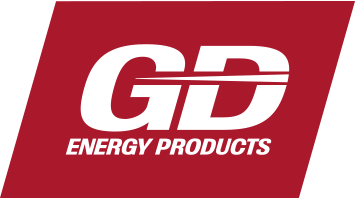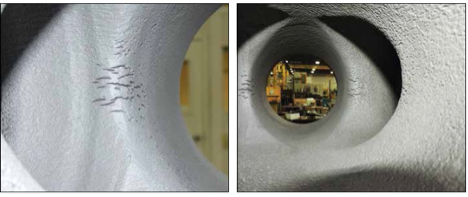


BY ADAM AVEY, GD ENERGY PRODUCTS
Cavitation is an undesirable condition that causes a reduction in pump efficiency and excessive wear/damage to pump components. Factors that can contribute to cavitation, such as fluid velocity and pressure, can sometimes be attributed to an inadequate mud system design and/or the diminishing performance of the mud pump’s feed system.
Other factors contributing to cavitation include:
• Improper sizing of charge pump;
• Improper maintenance of charge pump impellers – worn impellers cause a reduction of fluid pressure;
• Dirty or clogged charge pump feed and discharge lines;
• Improper size of plumbing from charge pump to mud pump;
• Elevation changes and excessive elbows in plumbing from mud tank to mud pump; and
• Lack of/or inadequate suction and discharge dampening.
Cavitation is an avoidable issue, but without proper inspection of the feed system it can accelerate the wear of fluid end parts. This can lead to expensive maintenance issues and a potentially catastrophic failure.
MILD VS SEVERE CAVITATION
When a mud pump has entered full cavitation, rig crews and field service technicians will see the equipment shaking and hear the pump “knocking,” which typically sounds like marbles and stones being thrown around inside the equipment. However, the process of cavitation starts long before audible signs reveal themselves – hence the name, “the silent killer.”
Mild cavitation begins to occur when the mud pump is “starved” for fluid. While the pump itself may not be making noise, damage is still being done to the internal components of the fluid end. Mild cavitation damages the module, piston and valve assembly. These hidden and intense shock waves generated by cavitation travel directly from the fluid end to the pump’s power end, causing premature damage (vibration) to the crosshead slides, thus passing onto the shaft, bull gear and into the main bearings. If not corrected, the vibrations caused by cavitation will work their way directly to these critical power end components, causing premature failure, expensive downtime and repair costs.
As referenced in Figures 1 and 2, the process of cavitation causes numerous pits to form on the module’s internal surface. Typically, cavitation pits result in a stress concentration that results in a reduced fatigue life of the module. Washouts are one of the leading causes of module failure and take place when the high-pressure fluid cuts through the module’s surface and damages a sealing surface. These unexpected failures are expensive and lead to a minimum of eight hours of rig downtime for module replacement.
PREVENTING CAVITATION
Stopping cavitation before it starts is a matter of routine inspection and maintenance.
For starters, install and tune highspeed pressure sensors on the mud suction line to alarm if the pressure falls below 30 psi. Accelerometers can also be used to detect slight changes in module performance and can be a good early warning system for cavitation prevention. Routinely conduct visual inspections on the pump. While the knocking may not be loud, if inspections are conducted on a regular basis, a field technician will be able to detect moderate vibrations or knocking sounds. Finally, maintain the gear end of the pump and check oil on a regular basis.
GD Energy Products offers Pump University (PumpU), a mobile classroom that travels to customers’ facilities and/or drilling rigs and trains rig crews on how to properly maintain pumping equipment. Participants in the program have found that their improved maintenance skills have extended the life of fluid end expendables on their sites, in addition to lowering repair costs, decreasing production costs and reducing workplace hazards.

FIGURES 1 (LEFT) and 2: Long-term, severe cavitation can cause surface pitting on a module crossbore and reduce the module’s fatigue life. Over time, cavitation can lead to expensive maintenance issues and a potentially catastrophic failure.
RESULTS OF CAVITATION
At the onset of cavitation, there will be reduced life in expendables and gradual wear on the modules and power end. Severe cavitation will drastically decrease module life and will eventually lead to catastrophic pump failure, causing unwanted and costly downtime. In addition, failure of the drilling pump can also cause damage to the suction and discharge piping.
CAVITATION IN THE FIELD
A leading North American drilling contractor encountered chronic mud system issues on multiple rigs. The company experienced more than 25 premature module washes in one year and a major power-end failure. GD Energy Products’ engineering team was called and spent time on the contractor’s rigs observing the pumps during operation and surveying the mud system’s design and configuration. The team discovered that the suction systems were undersized, feed lines were too small and there was no dampening on the suction side of the pump. There were also issues with the feed line maintenance – lines weren’t cleaned out on a regular basis and solids from the fluid had formed a thick cake on the bottom of the pipe, further reducing its diameter. The engineering team recommended increasing the diameter of the feed lines and routine cleanings to improve flow and reduce the risk of cavitation.
Following the implementation of these recommendations, the customer’s drilling pumps had significant improvements in performance. Consumables life has been extended significantly, and module washes have been reduced by nearly 85%. This improved performance has drastically reduced rig downtime and has increased the operational efficiency and customer satisfaction for the drilling contractor.
THE IMPACT OF TODAY’S DRILLING RIGS
While pump age does not affect its susceptibility to cavitation, the rig’s age can. Oftentimes, a rig’s mud systems aren’t equipped for the way pumps are run today – at maximum horsepower.
The best way to prevent pump cavitation is to check the system’s feed lines and equipment daily for any signs of abnormal noise or vibrations. Although it’s impractical to flush system piping during drilling operations, strainer screens should be checked daily to remove any debris or other flow restrictions. Additionally pre-charge (centrifugal) pumps should be inspected regularly to ensure output flow and pressure is adequate. Following these simple steps will allow you to achieve maximum performance from your pumping equipment and reduce unplanned equipment outages.
Learn More